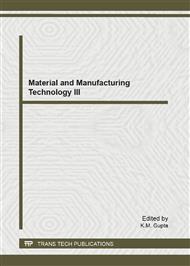p.382
p.387
p.393
p.398
p.406
p.415
p.421
p.425
p.429
Experiment Study on Vibration in Milling of Stainless Steel 304 in Time Domain and Frequency Domain
Abstract:
Vibration is a common phenomenon in cutting process, which is harmful for machining quality and machine tools. This paper focused on the occurrence and characteristics of vibration of the cutting tool and workpiece by changing cutting speed in milling of stainless steels 304. Vibration acceleration signals of both the cutting tool and the workpiece were sampled and analyzed in time domain and frequency domain. Vibration noise and vibration mark were used to judge the occurrence of violent vibration. In the experiments, both self-excited vibration and violent forced vibration were found at different value of cutting speed. Violent forced vibration was easy to be induced owing to interrupted continuous impulsion cutting.The Maximum amplitude of vibration acceleration signals varied with the cutting speed changing. With the cutting speed increased, the probability of violent vibration increased. Bigger amplitude of vibration will not always lead to vibration mark on surface of workpiece, obvious vibration mark only occurred when n=600 r/min and 700 r/min. In order to reduce the impact of violent vibration on machining quality, more attention should also be paid to the static and dynamics characteristics of the cutting tools and workpiece in milling of stainless steels.
Info:
Periodical:
Pages:
406-411
Citation:
Online since:
July 2012
Authors:
Keywords:
Price:
Сopyright:
© 2012 Trans Tech Publications Ltd. All Rights Reserved
Share:
Citation:


